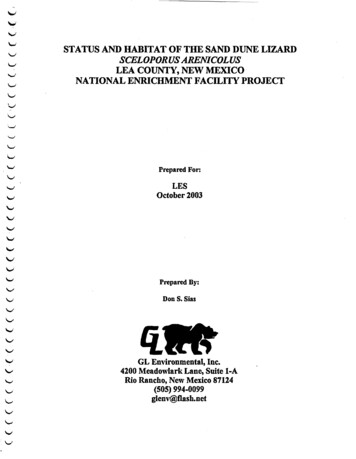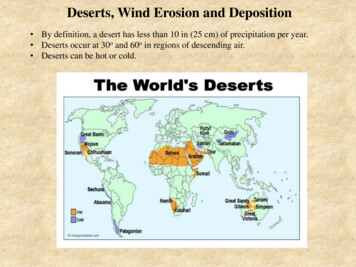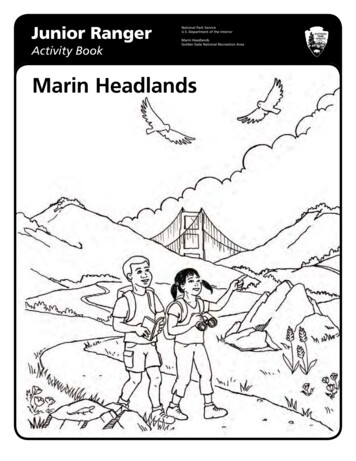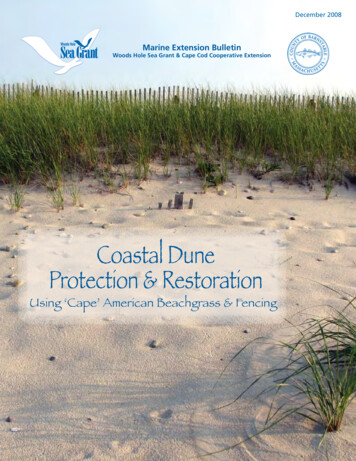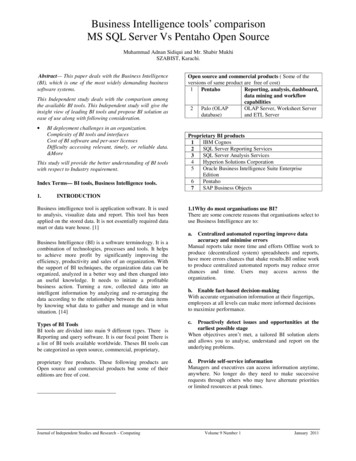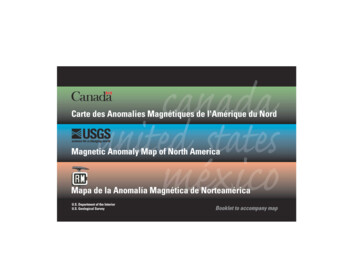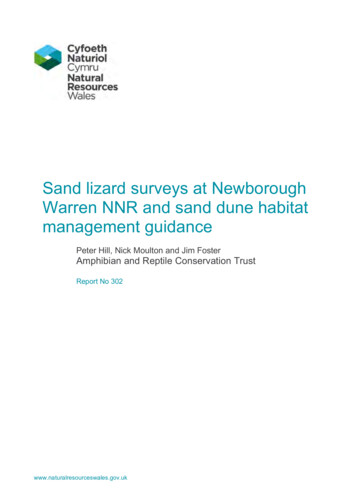
Transcription
Sand lizard surveys at NewboroughWarren NNR and sand dune habitatmanagement guidancePeter Hill, Nick Moulton and Jim FosterAmphibian and Reptile Conservation TrustReport No 302Datewww.naturalresourceswales.gov.uk
About Natural Resources WalesNatural Resources Wales’ purpose is to pursue sustainable management of naturalresources. This means looking after air, land, water, wildlife, plants and soil toimprove Wales’ well-being, and provide a better future for everyone.Evidence at Natural Resources WalesNatural Resources Wales is an evidence based organisation. We seek to ensure thatour strategy, decisions, operations and advice to Welsh Government and others areunderpinned by sound and quality-assured evidence. We recognise that it is criticallyimportant to have a good understanding of our changing environment.We will realise this vision by: Maintaining and developing the technical specialist skills of our staff; Securing our data and information; Having a well resourced proactive programme of evidence work; Continuing to review and add to our evidence to ensure it is fit for the challengesfacing us; and Communicating our evidence in an open and transparent way.This Evidence Report series serves as a record of work carried out or commissionedby Natural Resources Wales. It also helps us to share and promote use of ourevidence by others and develop future collaborations. However, the views andrecommendations presented in this report are not necessarily those of NRW andshould, therefore, not be attributed to NRW.www.naturalresourceswales.gov.ukPage 1
Report series:Report number:Publication date:Contract number:Contractor:Contract Manager:Title:Authors:Technical Editor:Peer ReviewerRestrictions:NRW Evidence Report302October 20188004055Amphibian and Reptile Conservation TrustM.A. EllisSand lizard surveys at Newborough Warren NNR andsand dune habitat management guidanceP. Hill, N. Moulton and J. FosterM.A. EllisE.A. HoweNoneDistribution List (core)NRW Library, BangorNational Library of WalesBritish LibraryWelsh Government LibraryScottish Natural Heritage LibraryNatural England Library (Electronic Only)211111Distribution List (others)Amphibian and Reptile Conservation Trust, BournemouthPaul Edgar, Natural EnglandJohn McKinnell, Scottish Natural HeritageRob Raynor, Scottish Natural HeritageNNR Warden, Newborough Warren, NRWNNR Warden teamEmmer Litt, NRWJulie Creer, NRWMatthew Ellis, NRWJane Garner, NRW3111111111Recommended citation for this volume:Hill P, Moulton N & Foster J. 2018. Sand lizard surveys at Newborough Warren NNRand sand dune habitat management guidance. NRW Evidence Report No: 302, 103pp, Natural Resources Wales, Bangor.Photo credits: all images by Peter Hill (Amphibian and Reptile Conservation) unlessotherwise stated.www.naturalresourceswales.gov.ukPage 2
Contents1.Crynodeb Gweithredol . 72.Executive Summary . 93.Part A: Main Report, Introduction . 113.1Background and aims of project .113.2Sand lizard ecology .123.2.1Habitat requirements .133.2.2Hibernation .193.2.3Egg-laying (oviposition) .193.2.4Population dynamics and dispersal .203.34.Methods. 234.1Recent sand lizard status, habitat condition and habitat associations .234.2Sand lizard survey and habitat condition assessment in September 2015 .234.2.14.35.Methods and effort .23Assessment of implications for sand lizards of dune re-mobilisation .244.3.1Implications for sand lizards at Newborough Warren NNR .244.3.2Implications for guidance on habitat restoration and management .244.3.3Implications for regulation and conservation planning .25Results . 265.1Recent sand lizard status, habitat condition and habitat association .265.2Sand lizard surveys in September 2015 .305.3Habitat condition in September 2015 .315.3.1Locations 1, 2, 3, 4 and 5 .315.3.2Locations 6, 7, 8 and 9 .355.46.Dune re-mobilisation works at Newborough Warren in winter 2014-15 .20Comparing habitat condition before and after management .37Discussion . 426.1Effects of dune re-mobilisation works on the sand lizard population at NewboroughWarren NNR.426.2General issues raised by dune re-mobilisation impacts on sand lizards .446.3Implications for guidance on habitat restoration and management .466.4Implications for regulation and conservation planning .476.4.1Key drivers and constraints for habitat works on sand lizard sites .476.4.2Reconciling designated site and protected species issues .496.4.3Recommendations for future re-mobilisation projects .526.5Recommendations for future investigations .546.5.1Further surveys at Newborough Warren .546.5.2Surveys at other sand dune sites supporting sand lizards .556.5.3Further spatial analysis .556.6Conclusions.557.Acknowledgements. 568.References . 57www.naturalresourceswales.gov.ukPage 3
9.Annex1: Use of sand dunes by herpetofauna other than sand lizards . 599.1.Amphibians .599.2.Reptiles .619.3.Adder (Vipera berus) .639.4.Grass snake (Natrix natrix) .639.5.Common lizard (Zootoca vivipara) .649.6.Slow-worm (Anguis fragilis) .6410. PART B: Results from 2015 site surveillance . 6610.1.Summary of observations .6610.2.Detailed results .6610.3.Conclusions from September 2015 surveys .7611. PART C: Recommendations for short-term habitat enhancement measures . 7711.1.Potential short-term impacts of re-mobilisation measures on sand lizards .7711.2.Recommended short-term habitat enhancement measures .7712. PART D: Suggested Annex for the Reptile Habitat Management Handbook; guidance fordune renovation management on sand lizard sites . 8112.1.General guidance to inform sand dune re-mobilisation works when sand lizards arepresent .8112.1.1.General points .8112.1.2.Survey .8212.2.Harm avoidance measures .8412.3.Timing of management works .8612.4.Recommendations for dune rejuvenation work methods to reduce impacts on sandlizards .8713. Part E: Suggested Annex for Reptile Habitat Management Handbook; sand dune habitatmanagement for reptiles. . 9013.1.Sand Dune Habitat Management Guidance for Reptiles .9013.1.1.Introduction .9013.1.2.Reptile habitat requirements on sand dunes .9013.1.3.Reptile Monitoring and Population Status .9213.1.4.Assessing impacts on reptile populations and dune habitats .9213.1.5.Management Operations .9313.1.6.High level impacts on sand dunes .9313.1.7.Medium level impacts on sand dunes: .9513.1.8.Low-Medium level impacts on dunes .9613.2.Management Summary.10013.3.Mitigating adverse impacts of habitat management .10114. References . 10215. Data Archive Appendix . 102www.naturalresourceswales.gov.ukPage 4
List of PlatesPlate 1 Plate 2 .Plate 3 .Plate 4 .Plate 5 .Plate 6 .Plate 7 .Plate 8 .Plate 9A Plate 9B Plate 10A .Plate 10B .Plate 11 Plate 12 Plate 13 Plate 14 Plate 15 Plate 16 Plate 17 Plate 18 Plate 19 Plate 20 Plate 21 Plate 22 Plate 23 Plate 24 Plate 25 Plate 26 Plate 27 Plate 28 Plate 29 Plate 30 Plate 31 Plate 32 Plate 33 Plate 34 Plate 35 Plate 36 Plate 37 Plate 38 .Plate 39 .Plate 40 9697070717983868891919494969797100100List of TablesTable 1 . 74Table 2 . 74Table 3 . 92www.naturalresourceswales.gov.ukPage 5
List of MapsMap 1 .Map 2 .Map 3 .Map 4 .Map 5 .Map 6 .Map 7a Map 7b Map 8 .Map 9 .Map 10 Map 11 Map 12 Map 13 Map 14 Map 15 Map 16 Map 17 List of FiguresFigure 1 940414654727374789153Page 6
1.Crynodeb GweithredolMadfall y tywod, Lacerta agilis yw'r fadfall brinnaf ym Mhrydain ac mae wedi cael eihailgyflwyno'n llwyddiannus i Gymru, a hynny wedi iddi diflannu o’r wlad. Mae i’wchanfod ar safleoedd twyni tywod yng Nghymru, ac mae mwy a mwy o enghreifftiauo gynefinoedd o'r fath yn gorsefydlogi. Yn aml, argymhellir bod gwaith adfer yn caelei gyflawni er mwyn datrys y sefyllfa hon, ac mae manteision gwaith o’r fath, o randynameg y systemau twyni a rhywogaethau arbenigol y twyni, wedi’i gofnodi.Mae Cwningar Niwbwrch a Gwarchodfa Natur Genedlaethol Ynys Llanddwyn ar YnysMôn yn safle gwarchodedig sy'n cynnal system fawr o dwyni tywod. O ganlyniad iorsefydlogi, mae maint y tywod agored yng Nghwningar Niwbwrch wedi gostwng94% ers y 1940au, ac oherwydd ei statws safle gwarchodedig gwnaed gwaithsylweddol i’w adfer yn ystod gaeaf 2014-15. Golygodd hyn ddefnyddio peiriannautrymion i dorri rhiciau yn y blaendwyni, ynghyd â dileu glaswelltir o’r twyni ôl.Mae poblogaeth o fadfallod y tywod i’w chael yng Nghwningar Niwbwrch, y credir iddifod yno o ganlyniad i fod wedi cael eu rhyddhau yno heb ganiatâd (yn wahanol i'rrhan fwyaf o boblogaethau Cymru sy'n tarddu o raglen ailgyflwyno wedi’i chynllunio).Er gwaethaf ei tharddiad anawdurdodedig tebygol a'r posibilrwydd i hynny ddileugwarchodaeth y Gyfarwyddeb Cynefinoedd, mae'n debyg bod Cyfoeth NaturiolCymru yn ystyried bod y boblogaeth yn cyfateb yn gyfreithiol i boblogaeth frodorolneu boblogaeth wedi'i hailgyflwyno'n ffurfiol. Fe ymddengys fod hwn yn benderfyniadpragmataidd yn sgil yr opsiynau i ailgyflwyno’r rhywogaeth.Lleisiwyd pryderon ynghylch y ffaith fod y gwaith o adfer y twyni’n effeithio'nuniongyrchol ar boblogaeth madfall y tywod. Y prif bryderon oedd y perygl ofarwolaethau yn sgil y gwaith ar y tir, a'r lleihad ym maint y cynefinoedd a'r cysyllteddrhyngddynt o ganlyniad i greu ardaloedd mawr o dywod agored.Casglwyd gwybodaeth gennym o ystod o ffynonellau gwybodus er mwyn asesueffeithiau tebygol y gwaith o adfer y twyni ar boblogaeth madfall y tywod yngNghwningar Niwbwrch. Cynhaliwyd asesiadau cynefinoedd ac arolygon ym mis Medi2015. Casglwyd gwybodaeth a'i dadansoddi gan ddefnyddio’r system gwybodaethddaearyddol (GIS).Canfuwyd fod y gwaith o adfer y twyni’n debygol o fod wedi effeithio ar boblogaethmadfall y tywod mewn sawl gwahanol ffordd, a hynny’n gyda chanlyniadaucadarnhaol a negyddol. Yn gyntaf, mae bron yn sicr bod rhai anifeiliaid wedi’u lladdgan y broses. Yn ail, mae canlyniad uniongyrchol y gwaith wedi golygu colled netfechan o gynefin o ansawdd uchel a lleihad mewn cysylltedd ar y safle. Aseswyd bodtua 17% o’r cynefinoedd wedi’u colli, a llawer o'r rhain y cynefinoedd o'r ansawdduchaf oedd ar y safle. Mae cynefin o ansawdd uchel i’w chael mewn tair ardal fechanac un ardal fwy erbyn hyn, yn hytrach nag mewn un llain fawr fel ag yr oedd cyncyflawni’r gwaith. Yn drydydd, bu gwelliant yn y rhagolygon tymor hir ar gyfer cynnalcynefinoedd y blaendwyni drwy ddynameg aeolaidd, a ddylai fod o fudd i boblogaethmadfall y tywod yn yr hirdymor, yn dilyn unrhyw effeithiau tymor byr.www.naturalresourceswales.gov.ukPage 7
Dangosodd arolygiadau yn 2015 fod poblogaeth madfall y tywod yn dal i fodoli, acawgrymwyd bod ganddi broffil demograffig gweddol. Canfuwyd madfallod y tywod ynagos iawn i ardaloedd a oedd wedi’u hadfer, yn ogystal â mewn ardaloedd nadeffeithiwyd arnynt yn uniongyrchol. Fodd bynnag, oherwydd amgylchiadau y tu hwnti'n rheolaeth, cyfyngedig oedd yr arolygiadau ac nid oedd eu hamseriad yn ddelfrydolychwaith ac o’r herwydd roeddent yn annigonol o ran gallu asesu statws presennol yboblogaeth yn drylwyr ac asesu’r rhagolygon ar gyfer dyfodol y boblogaeth.Ar sail yr wybodaeth gyfredol, daethom i'r casgliad y bydd poblogaeth madfall ytywod Niwbwrch yn parhau yn yr hirdymor er gwaethaf effeithiau negyddol tymor byry gwaith o adfer. Serch hynny, rydym yn argymell yn gryf y dylid cynnal arolygiadaupellach er mwyn asesu'r sefyllfa'n fwy trylwyr. Fel rhagofal, rydym yn argymellopsiynau ar gyfer gwella cynefin fel ffordd o wrthbwyso’r colledion tymor byr yngnghysylltedd cynefinoedd. Mae'r ardal fawr o goedwigaeth yng NghwningarNiwbwrch yn gyfyngiad arbennig ar adferiad dynameg naturiol y twyni.Canfuom rai diffygion yn y prosesau rheoleiddio sy'n ymwneud ag effeithiau posibl ygwaith o adfer y twyni ar fadfall y tywod. Nid oedd y drwydded a gyhoeddwyd ganCNC at ddibenion cadwraeth yn cyd-fynd â'r gweithrediadau trwyddedadwy a oeddyn debygol o fod yn rhan o’r gwaith. Nid ymddengys bod datganiad dull wedi’i lunio ermwyn sicrhau bod rheolaeth y gwaith yn cael ei weithredu gyda mesurau lleihau risgaddas, h.y. mesurau lliniaru er mwyn osgoi a lleihau’r lladd, yr anafu, yr aflonyddu adifrodi elfennau allweddol o gynefin madfall y tywod. Yn ogystal, fe ymddengys naroddwyd digon o ystyriaeth i gysoni amcanion rhywogaethau (h.y. dyheadau CNC argyfer madfall y tywod yn yr ardal hon) gydag amcanion safleoedd gwarchodedig (h.y.canlyniadau dymunol y Warchodfa Natur Genedlaethol). Pe bai'r holl brosesau hynwedi cael eu gweithredu a'u hintegreiddio'n well, gellid bod wedi ymgymryd â'r gwaitho adfer mewn modd a fyddai wedi lleihau’n sylweddol y perygl o niwed i fadfall ytywod, wedi gwneud y gorau o'r manteision i fadfall y tywod, ac wedi sicrhau lefeluwch o gydymffurfiad cyfreithiol.Yn y dyfodol, wrth gyflawni gwaith adfer y twyni, dylid mynd ati'n rhagweithiol iasesu'r risgiau byrdymor a hirdymor ynghyd â'r manteision i fadfall y tywod. Gallgwaith adfer fod yn gyson â'r gwaith hynod o gadarnhaol y mae CNC a’u partneriaidwedi'i gyflawni o ran adfer madfall y tywod yng Nghymru. Wrth gynllunio adfer y twynidylid ystyried symudiad pellach tuag at sicrhau Statws Cadwraeth Ffafriol ar gyfer yrhywogaeth hon, ond nid ydym yn rhagweld unrhyw wrthdrawiad na ellir ei ddatrys.Ar gyfer gwaith adfer yn y dyfodol pan fo madfallod y tywod yn bresennol (ac yn wir,rywogaethau eraill sydd dan fygythiad yn yr un modd), dylid ystyried y trafodaethausydd ymhlith ymarferwyr Ewropeaidd ynglŷn â rhinweddau cymharol dulliau o adferar raddfa fawr o’u cymharu ag adfer mosaig.Awgrymwn broses ar gyfer asesu'r risgiau posibl sy'n gysylltiedig â gwaith rheoli,ynghyd ag opsiynau ar gyfer rheoli effeithiau negyddol tymor byr a thymor hir. Maeangen ymgorffori deinameg systemau twyni tywod ac effeithiau tebygol newid yn yrhinsawdd yn y gwaith o gynllunio ar gyfer rheoli poblogaethau madfall y tywod ardwyni tywod. Rydym hefyd yn rhoi arweiniad ar faterion ehangach rheoli cynefinoeddwww.naturalresourceswales.gov.ukPage 8
twyni tywod ar gyfer ymlusgiaid, ynghyd â nodiadau ar werth twyni tywod iherpetoffawna’n fwy cyffredinol.2.Executive SummaryThe sand lizard Lacerta agilis is Britain’s rarest lizard and has been successfullyreintroduced to Wales following regional extinction. It occurs on sand dune sites inWales, and such habitats are increasingly subject to over-stabilisation. Remobilisation works are often recommended to remedy this situation, with documentedbenefits to dune system dynamics and dune specialist species.Newborough Warren and Ynys Llanddwyn National Nature Reserve on Anglesey is aprotected site supporting a large sand dune system. Through over-stabilisation, theextent of bare sand at Newborough Warren has declined by 94% since the 1940s,and its protected site status led to substantial re-mobilisation in winter 2014-15. Theworks were done using heavy machinery and involved the cutting of notches in thefrontal dunes, combined with stripping of grassland to the rear.A population of sand lizards occurs at Newborough Warren, thought to result fromunauthorised releases (unlike most Welsh populations, which originate from aplanned reintroduction programme). Despite its likely unauthorised origin and theimplication that this could obviate Habitats Directive protection, the population isapparently considered by NRW legally equivalent to a native or formally reintroducedpopulation. This appears to be a pragmatic decision in the light of reintroductionoptions for the species.Concerns were raised that the re-mobilisation works directly impacted on the sandlizard population. The key issues were the risk of lizard mortality via groundworks,and the reduction in habitat extent and connectivity due to the creation of large areasof bare sand.We collected information from a range of informed sources to assess the likelyimpacts of the re-mobilisation works on the sand lizard population at NewboroughWarren. Habitat assessments and surveys for sand lizards were conducted inSeptember 2015. Information was collated and analysed using GIS.We found that the sand lizard population is likely to have been affected by the remobilisation works in several distinct respects, with both positive and negativeoutcomes. Firstly, it is almost certain that some animals were killed by the worksthemselves. Secondly, the immediate outcome of the works has resulted in a smallnet loss of high quality habitat and a reduction in within-site connectivity. Weassessed the loss of habitat extent at approximately 17%, with much of this being thehighest quality habitat on the site. High quality habitat now occurs in three small andone larger patch, as opposed to a single large patch before the works. Thirdly, therehas been an increase in the long-term prospects for maintaining frontal dune habitatsvia aeolian dynamics, which should benefit the sand lizard population in the long termfollowing any short-term impacts.www.naturalresourceswales.gov.ukPage 9
Surveys in 2015 demonstrated that the sand lizard population persists, andsuggested it has a reasonable demographic profile. Sand lizards were found veryclose to areas subject to re-mobilisation, as well as in areas not directly affected.However, due to circumstances beyond our control these surveys were undertakenwith constrained effort and sub-optimal timing and were therefore insufficient tothoroughly assess the current status and future prospects of the population.On the basis of current information, we tentatively conclude that the NewboroughWarren sand lizard population will persist in the long term despite the short-termnegative effects of re-mobilisation works. Nevertheless, we strongly recommendfurther surveys to assess the situation more thoroughly. As a precautionary measure,we recommend options for enhancing habitat as a way to offset short-term reductionsin habitat connectivity. The large area of forestry at Newborough Warren is aparticular constraint to restoring natural dune dynamics.We found some short-comings in the regulatory processes relating the potentialimpacts of the re-mobilisation works on sand lizards. The licence that NRW issued forconservation purposes was not consistent with the licensable operations likely tohave been involved in the works. There does not appear to have been a methodstatement to ensure management was implemented with suitable risk reductionmeasures, i.e. mitigation measures to avoid and reduce killing, injuring, disturbanceand damage to key elements of sand lizard habitat. Moreover, there appears to havebeen inadequate consideration in aligning species objectives (i.e. NRW’s aspirationsfor sand lizards in this area) with protected site objectives (i.e. the desired outcomesof the NNR). Had all of these processes been better implemented and integrated, there-mobilisation works could have been undertaken in a way that substantiallyreduced the risk of harm to sand lizards, maximised the benefits to sand lizards, andensured a higher level of legal compliance.Future sand dune re-mobilisation works should proactively assess the short-term andlong-term risks and benefits to sand lizards. Re-mobilisation can be consistent withthe extremely positive work that NRW and partners have achieved in recovering thesand lizard in Wales. Further progression towards achieving FavourableConservation Status for this species should be considered when planning remobilisation, yet we do not envisage unresolvable conflicts. The emergingdiscussions among European practitioners about the relative merits of large-scaleversus mosaic restoration approaches should be considered for future re-mobilisationwhere sand lizards occur (and indeed other species with similar vulnerabilities).We suggest a process for assessing the potential risks of management works, alongwith options for managing both short-term and long-term negative effects. Thedynamics of sand dune systems and the likely impacts of climate change need to beincorporated into planning for managing sand lizard populations on sand dunes. Wealso provide guidance on broader sand dune habitat management issues for reptiles,along with notes on the value of sand dunes to herpetofauna more generally.www.naturalresourceswales.gov.ukPage 10
3.Part A: Main Report, Introduction3.1 Background and aims of projectThe sand lizard Lacerta agilis is Britain’s rarest species of lizard. In the last century,the sand lizard has lost an estimated 80% of its range in the UK. The species waslost entirely from Wales in the 1960s. A collaborative reintroduction programme ledby Amphibian and Reptile Conservation (ARC) and Natural Resources Wales (NRW)(and their predecessor organisations) re-established the species on coastal dunesites in North Wales in the 2000s. Monitoring has revealed encouraging signs thatthe reintroduced populations have established and, in some cases, expandedsignificantly.Newborough Warren and Ynys Llanddwyn National Nature Reserve (NNR) onAnglesey, northwest Wales, incorporates a large sand dune system noted for itsimportant flora, fauna and coastal landscape features. The area is also subject toother more or less coincident designations, Abermenai to Aberffraw Dunes SAC andNewborough Warren - Ynys Llanddwyn SSSI. For simplicity, in this report we refer tothe area as Newborough Warren. During winter 2014-5, the site managers, NaturalResources Wales (NRW) undertook substantial works to re-mobilise the sand dunesystem at Newborough Warren. It has been estimated that the site has lost 94% ofbare sand cover since the 1940s. Dune re-mobilisation (or de-stabilisation) is ahabitat restoration method deployed at sites where coastal dunes have become overfixed. It is increasingly used to recover sites suffering from over-stabilisation, withencouraging results.Newborough Warren supports sand lizards, although they are thought to originatefrom an unauthorised release because no releases from the formal reintroductionprogramme have occurred there, and it is extremely unlikely that a native populationwould have gone undetected. The re-mobilisation works at Newborough Warrenwere subject to a European Protected Species licence, issued by NRW forconservation purposes. However, concern was
Warren NNR and sand dune habitat management guidance Peter Hill, Nick Moulton and Jim Foster Amphibian and Reptile Conservation Trust Report No 302 Date . www.naturalresourceswales.gov.uk Page 1 About Natural Resources Wales Natural Resources Wales' purpose is to pursue sustainable management of natural
